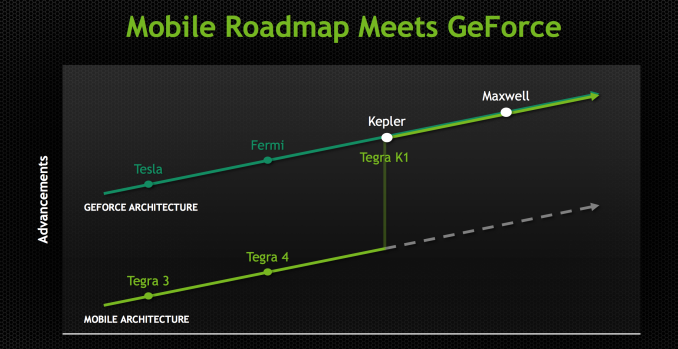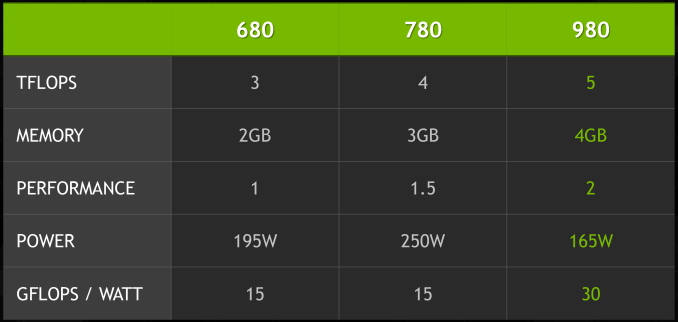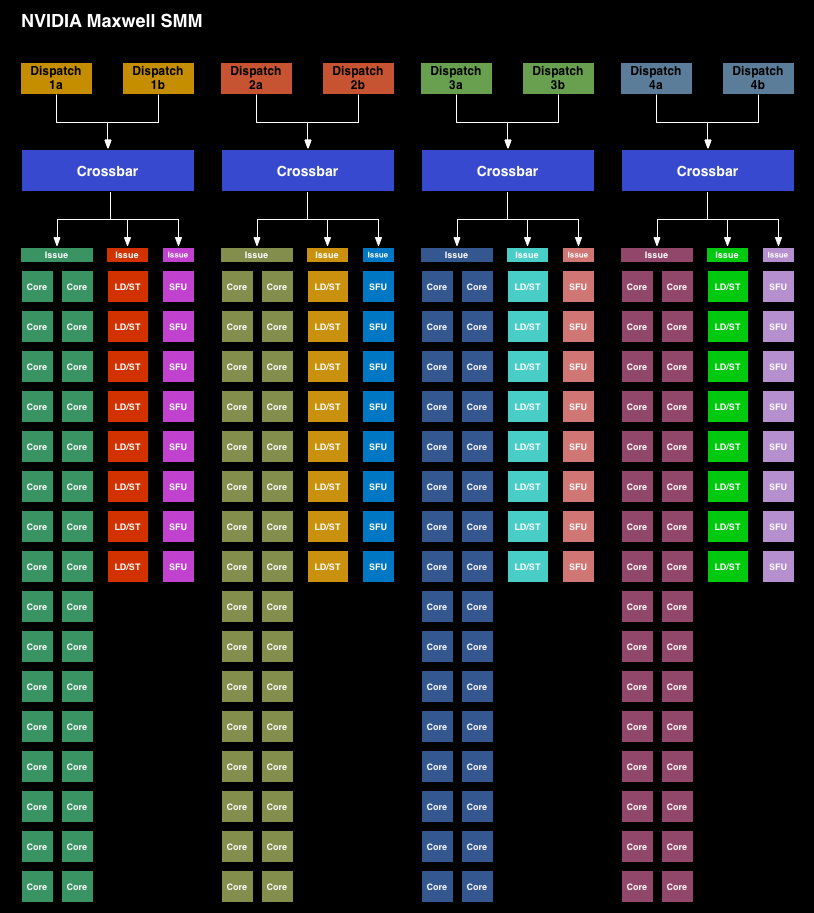The NVIDIA GeForce GTX 980 Review: Maxwell Mark 2
by Ryan Smith on September 18, 2014 10:30 PM ESTMaxwell 1 Architecture: The Story So Far
Before we dive into the story and architecture of Maxwell 2, we’d like to spend a bit of time recapping what we’ve seen so far with Maxwell 1 and the GM107 GPU. While both GPUs are distinctly Maxwell, Maxwell 2 is essentially a second, more feature-packed version of Maxwell. Meanwhile it retains all of the base optimizations that went into Maxwell 1, implemented on a larger scale for a larger GPU.
Beginning with the Maxwell family of architectures, NVIDIA embarked on a “mobile first” design strategy for GPUs, marking a significant change in NVIDIA’s product design philosophy. As of Maxwell NVIDIA’s top-down philosophy that saw the launch of high-end desktop class GPUs come first has come to an end, and as NVIDIA has chosen to embrace power efficiency and mobile-friendly designs as the foundation of their GPU architectures, this has led to them going mobile first on Maxwell. With Maxwell NVIDIA has made the complete transition from top to bottom, and are now designing GPUs bottom-up instead of top-down.
By going mobile first NVIDIA is aiming to address several design considerations at all once. First and foremost is the fact that NVIDIA is heavily staking the future of their company in mobile, and that means they need GPU designs suitable for such a market. This mobile first view is primarily focused on SoC-class products – the Tegra family – but really it even extends to mobile PC form factors such as laptops, where discrete GPUs can play an important role but are going to have strict thermal requirements. By designing GPUs around mobile first, NVIDIA starts with a design that is already suitable for Tegra and then can scale it up as necessary for laptop and desktop GeForce products. Graphics is – as we like to say – embarrassingly parallel, so if you can build one small module then it’s relatively easy to scale up performance by building chips with more modules and tying them together. This is the mobile first philosophy.
What this means is that NVIDIA is focused on power efficiency more than ever before. The SoC market is brutal for both the demands placed on the hardware and for the competitive nature of that market, and given the fact that SoCs are so heavily constrained by thermal and power considerations, every bit of power saved can be reinvested in additional performance. This in turn calls for a GPU that is especially power efficient, as it is efficiency that will win the market for NVIDIA.
Maxwell then is an interesting take on NVIDIA’s designs that does not radically alter NVIDIA’s architecture, but has had every accommodation made to improve energy efficiency. The result is a Kepler-like architecture with a number of small design tweaks that improve efficiency in some manner. As NVIDIA tells it, there is no single aspect of Maxwell that is disproportionally responsible for NVIDIA’s energy improvements, but rather it is the culmination of these small changes. Through these changes NVIDIA has been able to come close to doubling their performance per watt versus Kepler, which is nothing short of amazing given the fact that all of this is being done on the same 28nm process as Kepler.
Starting with the Maxwell 1 SMM, NVIDIA has adjusted their streaming multiprocessor layout to achieve better efficiency. Whereas the Kepler SMX was for all practical purposes a large, flat design with 4 warp schedulers and 15 different execution blocks, the SMM has been heavily partitioned. Physically each SMM is still one contiguous unit, not really all that different from an SMX. But logically the execution blocks which each warp scheduler can access have been greatly curtailed.
The end result is that in an SMX the 4 warp schedulers would share most of their execution resources and work out which warp was on which execution resource for any given cycle. But on an SMM, the warp schedulers are removed from each other and given complete dominion over a far smaller collection of execution resources. No longer do warp schedulers have to share FP32 CUDA cores, special function units, or load/store units, as each of those is replicated across each partition. Only texture units and FP64 CUDA cores are shared.
Among the changes NVIDIA made to reduce power consumption, this is among the greatest. Shared resources, though extremely useful when you have the workloads to fill them, do have drawbacks. They’re wasting space and power if not fed, the crossbar to connect all of them is not particularly cheap on a power or area basis, and there is additional scheduling overhead from having to coordinate the actions of those warp schedulers. By forgoing the shared resources NVIDIA loses out on some of the performance benefits from the design, but what they gain in power and space efficiency more than makes up for it.
NVIDIA still isn’t sharing hard numbers on SMM power efficiency, but for space efficiency a single 128 CUDA core SMM can deliver 90% of the performance of a 192 CUDA core SMX at a much smaller size.
Moving on, along with the SMM layout changes NVIDIA has also made a number of small tweaks to improve the IPC of the GPU. The scheduler has been rewritten to avoid stalls and otherwise behave more intelligently. Furthermore by achieving higher utilization of their existing hardware, NVIDIA doesn’t need as many functional units to hit their desired performance targets, which in turn saves on space and ultimately power consumption.
NVIDIA has also been focused on memory efficiency, both for performance and power reasons, resulting in the L2 cache size been greatly increased. NVIDIA has from 256KB in GK107 to 2MB on GM107, and from 512KB on GK104 to the same 2MB on GM204. This cache size increase reduces the amount of traffic that needs to cross the memory bus, reducing both the power spent on the memory bus and improving overall performance.
Increasing the amount of cache always represents an interesting tradeoff since cache is something of a known quantity and is rather dense, but it’s only useful if there are memory stalls or other memory operations that it can cover. Consequently we often see cache implemented in relation to whether there are any other optimizations available. In some cases it makes more sense to use the transistors to build more functional units, and in other cases it makes sense to build the cache. The use of 2MB of L2 cache in both GM107 and GM204 – despite the big differences in ROP count and memory bus size – indicates that NVIDIA’s settling on 2MB as their new sweet spot for consumer graphics GPUs.
Finally there’s the lowest of low level optimizations, which is transistor level optimizations. These optimizations are something of a secret sauce for NVIDIA, but they tell us they’ve gone through at the transistor level to squeeze out additional energy efficiency as they could find it. Given that TSMC 28nm is now a very mature process with well understood abilities and quirks, NVIDIA should be able to design and build their circuits to a tighter tolerance now than they would have been able to when working on GK107 and GK104 over 2 years ago.














274 Comments
View All Comments
Kutark - Sunday, September 21, 2014 - link
I'd hold on to it. Thats still a damn fine card. Honestly you could probably find a used one on ebay for a decent price and SLI it up.IMO though id splurge for a 970 and call it a day. I've got dual 760's right now, first time i've done SLI in prob 10 years. And honestly, the headaches just arent worth it. Yeah, most games work, but some games will have weird graphical issues (BF4 near release was a big one, DOTA 2 doesnt seem to like it), others dont utilize it well, etc. I kind of wish id just have stuck with the single 760. Either way, my 2p
SkyBill40 - Wednesday, September 24, 2014 - link
@ Kutark:Yeah, I tried to buy a nice card at that time despite wanting something higher than a 660Ti. But, as my wallet was the one doing the dictating, it's what I ended up with and I've been very happy. My only concern with a used one is just that: it's USED. Electronics are one of those "no go" zones for me when it comes to buying second hand since you have no idea about the circumstances surrounding the device and seeing as it's a video card and not a Blu Ray player or something, I'd like to know how long it's run, it's it's been OC'd or not, and the like. I'd be fine with buying another one new but not for the prices I'm seeing that are right in line with a 970. That would be dumb.
In the end, I'll probably wait it out a bit more and decide. I'm good for now and will probably buy a new 144Hz monitor instead.
Kutark - Sunday, September 21, 2014 - link
Psshhhhh.... I still have my 3dfx Voodoo SLI card. Granted its just sitting on my desk, but still!!!In all seriousness though, my roommate, who is NOT a gamer, is still using an old 7800gt card i had laying around because the video card in his ancient computer decided to go out and he didnt feel like building a new one. Can't say i blame him, Core 2 quad's are juuust fine for browsing the web and such.
Kutark - Sunday, September 21, 2014 - link
Voodoo 2, i meant, realized i didnt type the 2.justniz - Tuesday, December 9, 2014 - link
>> the power bills are so ridiculous for the 8800 GTX!Sorry but this is ridiculous. Do the math.
Best info I can find is that your card is consuming 230w.
Assuming you're paying 15¢/kWh, even gaming for 12 hours a day every day for a whole month will cost you $12.59. Doing the same with a gtx980 (165w) would cost you $9.03/month.
So you'd be paying maybe $580 to save $3.56 a month.
LaughingTarget - Friday, September 19, 2014 - link
There is a major difference between market capitalization and available capital for investment. Market Cap is just a rote multiplication of the number of shares outstanding by the current share price. None of this is available for company use and is only an indirect measurement of how well a company is performing. Nvidia has $1.5 billion in cash and $2.5 billion in available treasury stock. Attempting to match Intel's process would put a significant dent into that with little indication it would justify the investment. Nvidia already took on a considerable chunk of debt going into this year as well, which would mean that future offerings would likely go for a higher cost of debt, making such an investment even harder to justify.While Nvidia is blowing out AMD 3:1 on R&D and capacity, Intel is blowing both of them away, combined, by a wide margin. Intel is dropping $10 billion a year on R&D, which is a full $3 billion beyond the entire asset base of Nvidia. It's just not possible to close the gap right now.
Silma - Saturday, September 20, 2014 - link
I don't think you realize how many billion dollars you need to spend to open a 14 nm factory, not even counting R&D & yearly costs.It's humongous, there is a reason why there are so few foundries in the world.
sp33d3r - Saturday, September 20, 2014 - link
Well, if the NVIDIA/AMD CEOs is blind enough and cannot see it coming, then intel are gonna manufacture their next integrated graphics on a 10 or 8 nm chip and though immature will be a tough competition to them in terms of power and efficiency and even weight.remember currently pcs load integrated graphics as a must by intel and people add third party graphics only 'cause intels is not good enough literally adding weight of two graphics cards (Intels and third partys) to the product. Its all worlds apart more convenient when integrated graphics outperforms or able to challenge third party GPUs, we would just throw away NVIDIA and guess what they wont remain a monopoly anymore rather completely wiped out
Besides Intels integrated graphics are getting more mature in terms of not just die size with every launch, just compare 4000s with 5000s, it wont be long before they catch up.
wiyosaya - Friday, September 26, 2014 - link
I have to agree that it is partly not about the verification cost breaking the bank. However, what I think is the more likely reason is that since the current node works, they will try to wring every penny out of that node. Look at the prices for the Titan Z. If this is not an attempt to fleece the "gotta have it buyer," I don't know what is.Ushio01 - Thursday, September 18, 2014 - link
Wouldn't paying to use the 22nm fabs be a better idea as there about to become under used and all the teething troubles have been fixed.